Sharp Aquos LC-32LE210E Review
Sharp Aquos LC-32LE210E
Price and features all look promising, but what about overall performance?
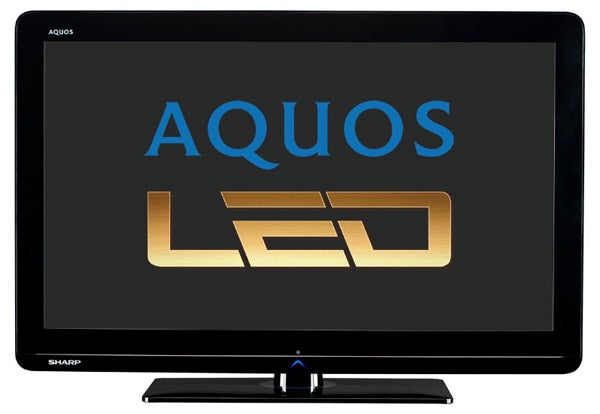
Verdict
Key Specifications
- Review Price: £414.68
Perhaps the best evidence of just how far LED lighting has now infiltrated the LCD TV world is the way the technology is now being used in small TVs as well as large ones.
We recently tested a 19in edge-LED set from Panasonic, the L19D28. And today we’re looking at a 32in edge-LED model from Sharp, following on from the Philips direct-LED 32PFL9705 a few weeks back.
The LC-32LE210E, as Sharp’s new edge-LED 32in TV is known, immediately seeks to underline its ‘cutting edge’ credentials by sporting a really elegant design that’s way more sophisticated and futuristic looking than your average 32in TV. The corners are all elegantly rounded off, the finish is exceptionally glossy, and the ultra-minimal black bezel sets off to perfection a cute little illuminated blue (red when the TV is in standby) version of Sharp’s current ‘mountain peak’ logo.
The cool design even extends to the TV’s rear, which is just as smooth, curvy and glossy as the front.
If you get within touching distance of the 32LE210E, it has to be said that the TV’s finish starts to appear just a touch plasticky. But from any sort of normal viewing distance, it looks much more opulent than you’d expect a £415-ish 32in TV to look.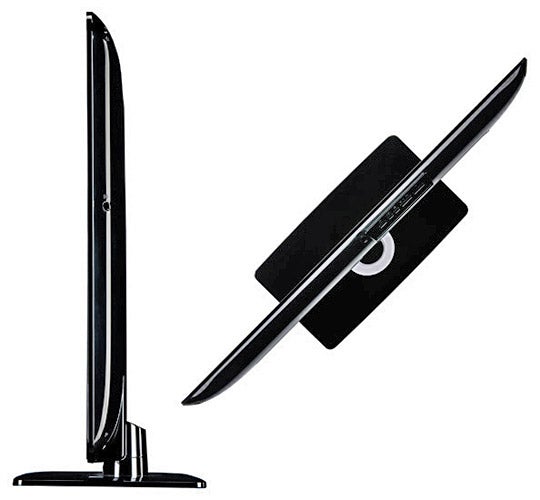
The 32LE210E really does cost less than £415. This would make it cheap even if it used CCFL lighting in its LCD panel, but it has the potential to be a bargain of monumental proportions for an edge-LED model. Especially when it quickly becomes apparent that its feature list isn’t the ultra-basic affair we might have anticipated.
For as well as its edge-LED lighting and a full HD native resolution, it delivers some surprising multimedia functionality too. A provided USB port proves able to not only play (DivX) video, music or photo files, but also record/timeshift programmes from the set’s digital tuner to USB storage devices. Although this feature is diminished by the fact that the TV only has one tuner, it’s still a rare but welcome finding for such a low-priced TV contender.
Given the dual functionality of the USB port, we guess it would have been nice if Sharp had included two of them. But maybe we’re just getting greedy. Just as we probably would be if we also expressed a wish that Sharp had put an Ethernet port on the 32LE210E, too!
People still living in an analogue age ought to note that the 32LE210E’s connections only contain a single Scart and no separate S-Video or composite video inputs. Though to be honest, we wouldn’t expect this to be a problem to the majority of our presumably reasonably tech-savvy readers.
Elsewhere, other important jacks you ”do” get include a D-Sub PC terminal, and a respectable if not earth-shattering three HDMIs.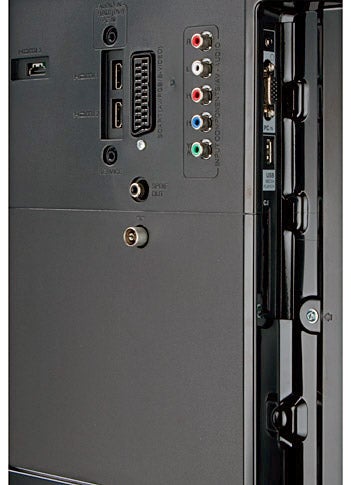
Readers who know their Freeview HD onions might have been troubled by the mention earlier of the 32LE210E’s lack of an Ethernet port. After all, such ports are a formal requirement of any TV carrying a Freeview HD tuner. And so it is that we’ve stumbled upon the one big feature compromise the 32LE210E expects you to swallow in return for its lowly price: there’s no Freeview HD tuner. Just standard def Freeview.
Heading into the 32LE210E’s unusually organised but very attractive and effective onscreen menus in search of more subtle features of note proves a slightly disappointing exercise. It becomes obvious, for a start, that the set really doesn’t have much going on in terms of picture processing. 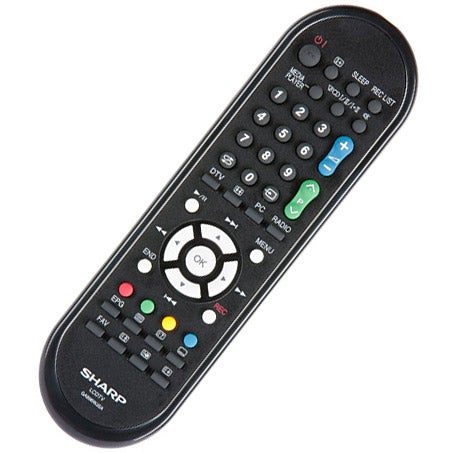
Certainly there’s no sign of any 100Hz technology, raising concerns about the set’s potential motion handling. Nor is there much to keep tweakers busy, with the most ‘high-tech’ adjustments on offer being nothing more than a simple backlight adjustment and a straightforward noise reduction system. Woo.
To be fair, Sharp could argue that people spending as little on a TV as they need to for the 32LE210E probably won’t be particularly worried about calibrating their new set to the nth degree. But let’s not forget that Toshiba has similarly priced TVs featuring some pretty extensive picture adjustment options – so if they can do it, it would have been great if Sharp had too.
At first glance, the 32LE210E’s pictures look very promising. There’s a real snap and punch to proceedings, with bright, richly saturated colours sitting alongside some surprisingly good black levels. What’s more, it soon becomes apparent that unusually for an edge-LED TV, the black levels are consistent across the screen. There are no obvious areas where the picture looks lighter than it does elsewhere, even at the TV’s corners. This is a real relief given the problems we had with this flaw in our recent review of Toshiba’s 40WL753 edge-LED set.
Blu-ray material sometimes looks pleasingly sharp and detailed too, and standard definition isn’t too ugly considering there doesn’t seem to be much processing devoted to tidying it up. That said, while standard def doesn’t look too noisy for the most part, this may be because the 32LE210E is hiding the noise behind a slightly soft overall tone.
Recordings made from the Freeview tuner to a USB stick do, at least, not look any softer or noisier than the original broadcasts.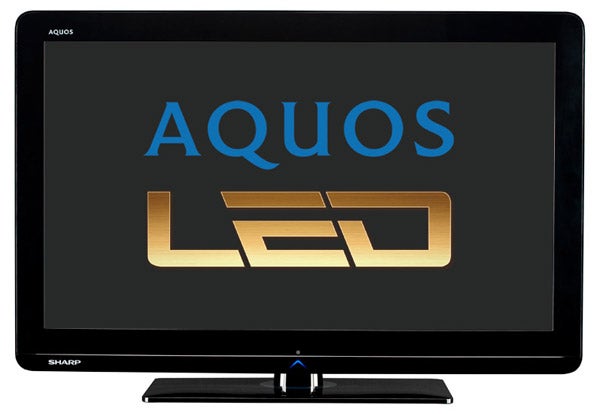
Having seen past the 32LE210E’s strong first impressions to spot the gentle softness issue with standard definition material, our eyes also start to pick out a few other concerns. The worst of these revolves around motion, which causes noticeable blurring and resolution loss on the 32LE210E even when watching otherwise crisp HD material. Ah, 100Hz, where are you when we need you?!
Also troubling at times are the set’s colour tones. For while the potent approach to colour is certainly eye-catching, it also seems responsible for a few rogue tones. Skin tones in particular can sometimes look too pink or orange – and no amount of tinkering with the very limited settings available managed to get things completely right. Which obviously makes the lack of any colour management tools all the more poignant.
A final picture issue for some households will be that the screen is very viewing angle dependent. Start to watch it from any more than 30 degrees or so from straight on and the picture’s contrast plummets.
Sonically the 32LE210E joins many other recent Sharp TVs in being distinctly underwhelming. A pretty severe lack of raw power and dynamic range leaves all but the most basic audio mixes sounding compressed, muddy and frequently a little distorted, with full-on action sequences sounding almost laughably unconvincing.
Verdict
For a while, the cute-looking 32LE210E had us thinking it had all the makings of an excellent, good-value 32in TV, despite not having an HD tuner. But the longer we lived with the set, the more a slightly uncomfortable colour performance together with rather feeble audio and some noticeable motion issues dented our enthusiasm.
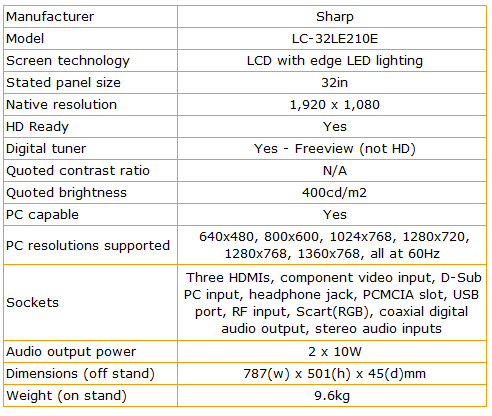
How we test televisions
We test every TV we review thoroughly over an extended period of time. We use industry standard tests to compare features properly. We’ll always tell you what we find. We never, ever, accept money to review a product.
Trusted Score
Score in detail
-
Features 7
-
Value 8
-
Image Quality 7
-
Design 8
-
Sound Quality 5
Features
| Size (Inch) | 32in |
| Display Type | LED |

